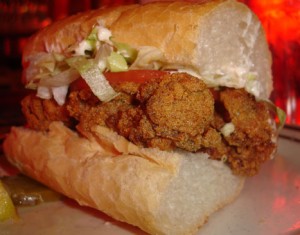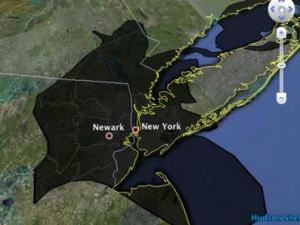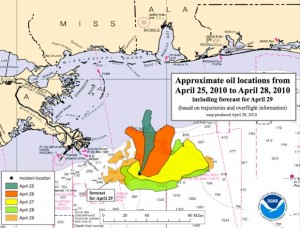On June 6, I wrote a blog posting about the importance of perception with respect to the safety of seafood harvested in the Gulf Coast. Today, The Economist asks “No mo’po’?” meaning “no more poor boys?” reflecting concerns about the fate of Gulf Coast oysters after the Deepwater Horizon spill. The po’boy, or poor boy, is a sandwich for which Louisiana is famous. My favorite is served at Brennan’s in New Orleans. Fresh oysters harvested from the Gulf Coast, which have a uniquely sweet flavor, are served in a sandwich made with French baguette breads. The taste is exquisite. The five Gulf Coast states (Texas, Louisiana, Mississippi, Alabama and Florida) harvest more than 20 million pounds of oysters annually, which sell on the market for about $60 million. Two-thirds of the oysters consumed in the U.S. come from the Gulf and while oysters are a less valuable harvest than shrimp, they are more difficult to replace. But the immediate concern, reports one fisheries owner quoted in the article, is the perception that the oysters are not safe to eat. Media reports of the oil spill have led consumers to shun Gulf Coast seafood, further compounding the economic losses. This is when small businesses in the Gulf Coast need us most; the seafood that has been harvested to date has been collected in areas unaffected by the spill and has been tested by authorities. And the Gulf shore is still a great place to take a vacation. I look forward to my next trip there.
Archive for the ‘Environmental Hazard’ Category
The Economist Reports on Louisiana Oysters
Friday, June 11th, 2010Spread the Word to Help Louisiana
Sunday, June 6th, 2010Food safety officials are taking a two-pronged approach to ensure that tainted seafood doesn’t reach consumers. First, one-third of the fishing areas of the Gulf of Mexico are closed because of the oil spill, ensuring that the fish are harvested in unaffected waters. Second, fish samples are tested for evidence of contamination, to add a second layer of protection to ensure food safety. Unfortunately, perception matters and these measures have not reassured consumers. The Director of the Louisiana Seafood Promotion and Marketing Board reports that buyers are canceling orders and more restaurants are posting notices that they are not selling seafood caught in the Gulf. Sadly, history may be repeating itself as buyers shunned Gulf seafood for two years after Hurricane Katrina, even though fishing waters were cleared as safe a month after the hurricane. The impact is significant as Louisiana’s seafood brand accounts for one-third of all U.S. production. For the commercial fishing businesses it is a triple impact: reduced harvests (Worldwide Shrimp reports that it would normally pack 250,000 pounds of Gulf Coast shrimp daily at this time of year versus 15,000 pounds now as a consequence of the oil spill); lower sales volumes owing to consumer fears and this occurring when shrimp prices are 50% higher than they were at this time last year. Perhaps one thing we could all do to help Louisiana is to purchase their seafood and spread the word about the adequacy of food safety measures.
Oil-Free Beach Guarantees Stem Losses for Gulf Coast Tourism
Sunday, May 30th, 2010The tourism industry in the Gulf Coast states is coming under pressure as the oil spill continues to expand its coverage area. Consumers are understandably reluctant to go forward with their vacation plans owing to concerns that oil slicks may effectively close the beaches. In Florida and Alabama, vacation resorts are changing their cancellation policies and offering oil-free beach guarantees, by which guests who see oil on the beaches may claim full refunds for their stay. It is similar in concept to the sunny day guarantee, whereby hotels comp guests when rain or inclement weather interferes with their plans. The Resort Collection of Panama City Beach proclaims on its Facebook page “The only oil on our beach is suntan oil!” The tourism in Louisiana is harder hit, as vacationers to that state don’t typically relax on the beach, they engage in activities such as sport fishing, which take them into deeper waters. Recreational fishing is closed for the moment. The hotels are occupied, not with tourists, but with recovery workers and journalists who are there because of the oil spill. Most of our tourism industry is in the small business sector, with individually owned, managed or franchised hotels, restaurants and tour operators. No doubt these businesses were under pressure to begin with as the recession is crimping consumer spending. On top of the economic disaster, the oil spill is another blow.
Preliminary Lessons in Crisis Management
Friday, May 28th, 2010The news from the Gulf Coast continues to alarm. The Associated Press reported workers’ accounts of the unfolding tragedy on the Deepwater Horizon drilling rig in the Gulf Coast. Imagine the horror the workers experienced as they attempted to walk across a bloody platform and remove debris from their colleagues’ bodies to see if they were alive and if they could be transported to the lifeboats. It is painful to read, but necessary. The report suggests certain preliminary lessons from the tragedy: first, management was clearly wearing rose-tinted glasses when they did their scenario planning, completely failing to envision a realistic disaster scenario. Second, BP failed to delegate authority to workers for immediate corrective action, resulting in costly delays as critical decisions went up and down the chain of command. Third, management put human safety below procedural formalities, preferring to do roll calls when an immediate evacuation was called for. Fourth, it does not appear that critical safety equipment was regularly tested to ensure its functionality. Fifth, the workers were improperly trained in life-saving procedures. One operator, for example, didn’t know how to detach the life boat from the rig. Everyone should be cross-trained in critical functions as you cannot anticipate in advance who will be available to respond to an emergency and in what capacity. Finally, the federal government abdicated responsibility for appropriate intervention, which decision is all the more baffling given that BP executives have given us no reason for confidence in their judgment calls. It is just a horrifying story all round.
Gulf Coast Environmental and Economic Catastrophe
Monday, May 10th, 2010The oil spill resulting from the April 20 explosion on the Deepwater Horizon now covers at least 2500 square miles of water surface. To help visualize the size of the spill, Paul Rademacher created Google Map mashups that show the spill placed over various cities. This image shows the spill if New York were the epicenter. As you can see, it is enormous, covering landmass in four states. As it is on the Gulf Coast, tar balls from the spill are washing up on local beaches with damage evident in Alabama, Louisiana and Mississippi. BP has offered US-based fishermen (the spill has not yet reached international waters) a one-month pay settlement package as compensation. All of the owners of Louisiana small fishing businesses with whom I have spoken have declined the offer, as their ultimate income loss will likely extend over a much longer period. It is important to remember that it is not just the commercial fishing businesses that will be affected. Many downstream businesses, such as seafood retailers and processing plants, face serious financial losses.
Yesterday the fishing waters in the Gulf were closed. With an annual harvest of more than one billion pounds of fish and shellfish, that equates to a lost harvest of 273,000 pounds each day. In response to this economic loss, the Small Business Administration is offering Economic Injury Disaster loans for small businesses in 13 Louisiana parishes and two Mississippi counties. The loans will offer working capital for up to $2 million at a 4% interest rate for a term of up to 30 years. Existing SBA borrowers who have been affected by the oil spill may request a deferment of their loans.
I explain the issues around the SBA’s Economic Injury Disaster Loans in Prepare for the Worst, Plan for the Best: Disaster Preparedness and Recovery for Small Businesses (Wiley, second edition 2009). I am particularly concerned in this case that insurance recoveries for the Gulf Coast fishing businesses may be inadequate to retire the proceeds of the SBA loans. Indeed, when I was just in Louisiana two weeks ago, I learned that insurance for small fishing businesses continues to remain unaffordable in the post-Katrina era. We do have a federal government fund established to finance the cleanup of oil spills. As it is funded by an eight-cent tax levied on each barrel of oil, it is insufficient for an environmental catastrophe such as this one. We need a comprehensive approach to disaster finance in the U.S. and one that is self-sustaining.
The Disaster Before Traditional Disaster Season
Thursday, April 29th, 2010The 2010 hurricane season does not start for another month, but small businesses in the Gulf Coast states are already facing a major threat to their livelihoods. More than 40,000 barrels of oil have been leaking into the Gulf of Mexico since April 20, when an explosion destroyed the Deepwater Horizon, which was drilling within 50 miles of Louisiana’s coastline. Eleven workers on that rig are unaccounted for and presumed dead. The cause of the explosion is not yet known. Crews are working round the clock to contain the expanding oil slick; deepwater robots are maneuvering to close the platform’s submerged valves. Burning the slick has been proposed as an option, but that creates air pollution and may further damage marine life. It could take months to contain the damage. Meanwhile, the oil spill could reach the shoreline of the Gulf Coast within days, threatening the oyster and shrimp industries and tourism. This comes at a time when the fishing industry is already struggling for its survival. It is threatened by lower-cost imports from Southeast Asia and unaffordable insurance at home. The fishing, shrimp and oyster industries are a major part of the Gulf Coast economy and have not yet recovered from the losses they sustained in Hurricane Katrina. We can only hope that the oil leakage is stopped as soon as possible and damages are minimized.
At Last?
Tuesday, January 26th, 2010Over eight years of negotiations over the fate of the former Deutsche Bank Building may be coming to an end. The building, located at 130 Liberty Street, faces the World Trade Center and became a serious environmental hazard on September 11, 2001. Now the Lower Manhattan Development Corp. (LMDC), established to oversee the reconstruction of the community following the terrorist attacks, may be close to resolving the expense of the building’s decontamination. Since 9-11, the building has been covered by a dark tarp to limit airborne contaminants of soot and ash released when the World Trade Center burned to the ground. Community activists opposed the proposed demolition of the building for fear of health effects to the local residents. Instead a compromise was negotiated: a staged decontamination and demolition process. But the process appeared jinxed as it dragged on for years, marred by horrific accidents and costly delays. In 2007, a fire broke out in the building, claiming the lives of two firemen. The building contractor admitted to wrongdoing in respect of its practices. The delays caused the costs of building decontamination to reach in excess of $200 million, provoking protest from the building’s insurers. The insurance companies have an excess of loss agreement in place to cover the decontamination costs. But the manner in which those costs have escalated necessarily gives rise to disputes over payments due. The LMDC and the insurance companies are reportedly close to concluding a financial settlement. Now comes the next round of disputes: what to do with any payments in excess of building remediation costs? Various groups are lobbying for their share of the spoils. Imagine what misery continues to exist for the residents and small businesses of disaster-ravaged communities who just want to put the tragedy behind them and get on with their lives.
Environmental Hazard in Pennsylvania
Sunday, March 22nd, 2009In Prepare for the Worst, Plan for the Best: Disaster Preparedness and Recovery for Small Businesses (John Wiley & Sons Inc., second edition, 2008), I set forth a framework for six disaster categories, including environmental hazards. It is important to understand that environmental hazards need not be Love Canal or Environmental Protection Agency Superfund level events. Even the most banal environmental hazards can disrupt the operations of your small business. Consider that on Saturday, evacuations were forced in Pennsylvania when a tractor-trailer transporting 33,000 pounds of corrosive hydrofluoric acid overturned. The acid is used for industrial purposes, such as etching glass and making high-octane gasoline, refrigerants, aluminum and light bulbs. Most of the acid in the vehicle was in the form of pressurized gas; inhaling the gas causes respiratory irritation, eye damage and pulmonary swelling. As a precaution, authorities ordered an evacuation of about 5,000 people within a mile radius of the accident in Plainfield Township. A pet-friendly shelter was set up at a local high school and the Red Cross was asked for assistance. The residents may not be allowed to return to their homes or offices for 24 hours.
I learned of a less dangerous incident that caused even more dislocation in rural Louisiana. I was delivering a “train the trainer” program to the technical counselors of Louisiana’s Small Business Development Centers when one of the staff shared an example of a recent disaster. A truck carrying products from a poultry processing plant overturned, spilling chicken fat across the bridge. The bridge was the sole transportation artery for that community and was closed for several days as civil authorities removed the contaminants. Local small businesses that were not set up for telecommuting on a temporary basis were disrupted for three to four days.
Prepare as best you can for these disruptions. Make sure your employees know that evacuation is not always the response to an environmental hazard. When contaminants are airborne, shelter in place may be the safer option. If you have employees who can telecommute, it is worth investing in a program for working from remote locations. What was unusual about the recent incident in Pennsylvania was that it made the national news. These events are so commonplace that they are not always reported.







